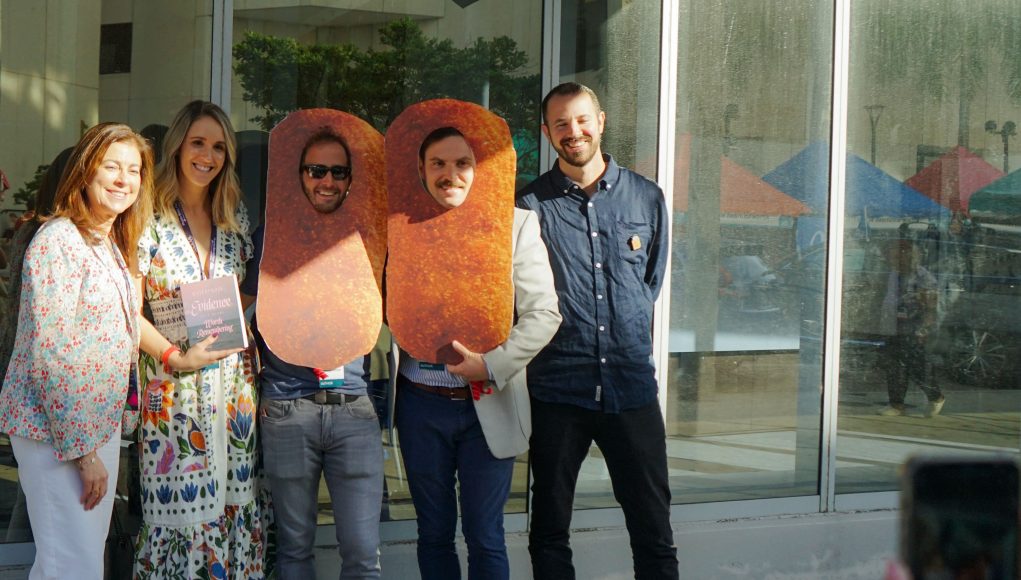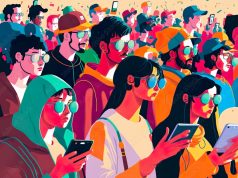The audience laughed as four South Florida locals lined up the Miami Book Fair stage, two of them wearing croqueta costumes to set a cultural ambiance.
Of all the topics covered by the 500 authors at the 40th Miami Book Fair, few brought as much insight – or humor – into the city’s quirks and unique culture.
The panelists – two authors, a poet and an investigative reporter – brought their own brand of comedy and serious critique into a conversation that touched on cultural stereotypes to climate change, finance and Miami’s affordable housing crisis.
The Nov. 19 panel, on the last day of the eight-day book fair, hosted Daniel Rivero, an investigative reporter for WLRN, Mario Ariza, author of ‘Disposable City,’ Andrew Otazo, author of ‘The Miami Creation Myth,’ and Caroline Cabrera, education director of ‘O, Miami,’ a non-profit organization that stages Miami’s annual poetry fest. Maria Alonso, regional dean and CEO of Northeastern University, introduced the group.
“You can’t step outside without something absolutely insane happening,” said Otazo, describing Miami. “You’re going to see road rage… depending on the time, iguanas falling off palm trees.”
Although Otazo appreciates the insanity of the city and enjoys the experience of running into many crazy people, “there is also a greater systemic craziness,” he said.
“The fact that our real-estate sector makes absolutely no sense and the fact that we’re going underwater and no one is doing anything about it.”
Miami is a city with a rich history, but its raw truth seems overshadowed in pop culture by shows and movies such as “Miami Vice” and “Scarface,” which are primarily made for consumption by people outside of Miami.
“We want Miamians to be telling the story of this city,” said Cabrera. “The international story told about Miami is not something those of us who live here really experience.”
Cabrera said “O Miami” strives to collect poems and broadcast them out to create a more equitable narrative of this city.
Otazo, speaking about his book, The Miami Creation Myth, said he wanted to capture the complex texture of the city.
“Miami is an incredible mosaic of dozens of communities, so that is why I went out of my way to incorporate the stories from members of these communities whether it’s the Seminole community, Haitian community, and LGBTQ+ community,” Otazo said.

Rivero said Miami is constantly changing and that there should be a record of what there is before it completely transforms into a southern Wall Street or goes underwater… or both.
“We need to create little time capsules,” said Rivero, encouraging Miami natives to share their own stories.
That idea intrigued audience member and Miami-Dade College photography student Neyman Canelo-Garcia.
“I think one of the ideas that really stuck with me was, once Miami is said and done and is already underwater, what are we going to leave behind? I thought that was a very sobering kind of idea.”
Canelo-Garcia is a Miami native who loves the city he grew up in, but fears gentrification and the construction of luxury condos and high-rises are changing it – and not for the better.
“What’s left of Miami is going to be these tall buildings that really have nothing to do with Miami because the people from Miami can’t even live there!”
“Until things get more affordable, it is an uphill battle,” Rivero said.
The condo boom threatens Miami’s history, the panelists said – and as an example, they talked about how the removal of a building in Miami’s Brickell district uncovered a 7,000-year-old site linked to the Tequesta Native American Tribe.
“Just across the river there is a major archaeological find, historically important for the entire world, that is about to be built upon,” Rivero said.
…” Keep buying those condos, people,” Ariza said with a sarcastic tone.
Ariza said that real estate developers coming to Miami are changing the nature of the city but it is a challenge locals have to “superar,” or overcome.
There are “unexpected rewards of telling the stories about your city,” Ariza said. Speaking out on Miami’s challenges and sharing authentic stories contributes to the city’s history, creating a community seeking a better future.
Miami’s issues are many, but Cabrera has faith that the young students she works with can make a difference. “They are the ones that are going to deal with everything we set them up with,” said Cabrera.
“There is a hopefulness in the way they tell the stories of this place that I think, when I hear them, I want to do right by them. The more we can uplift those voices, maybe we can convince people to do right by these kids.”

































